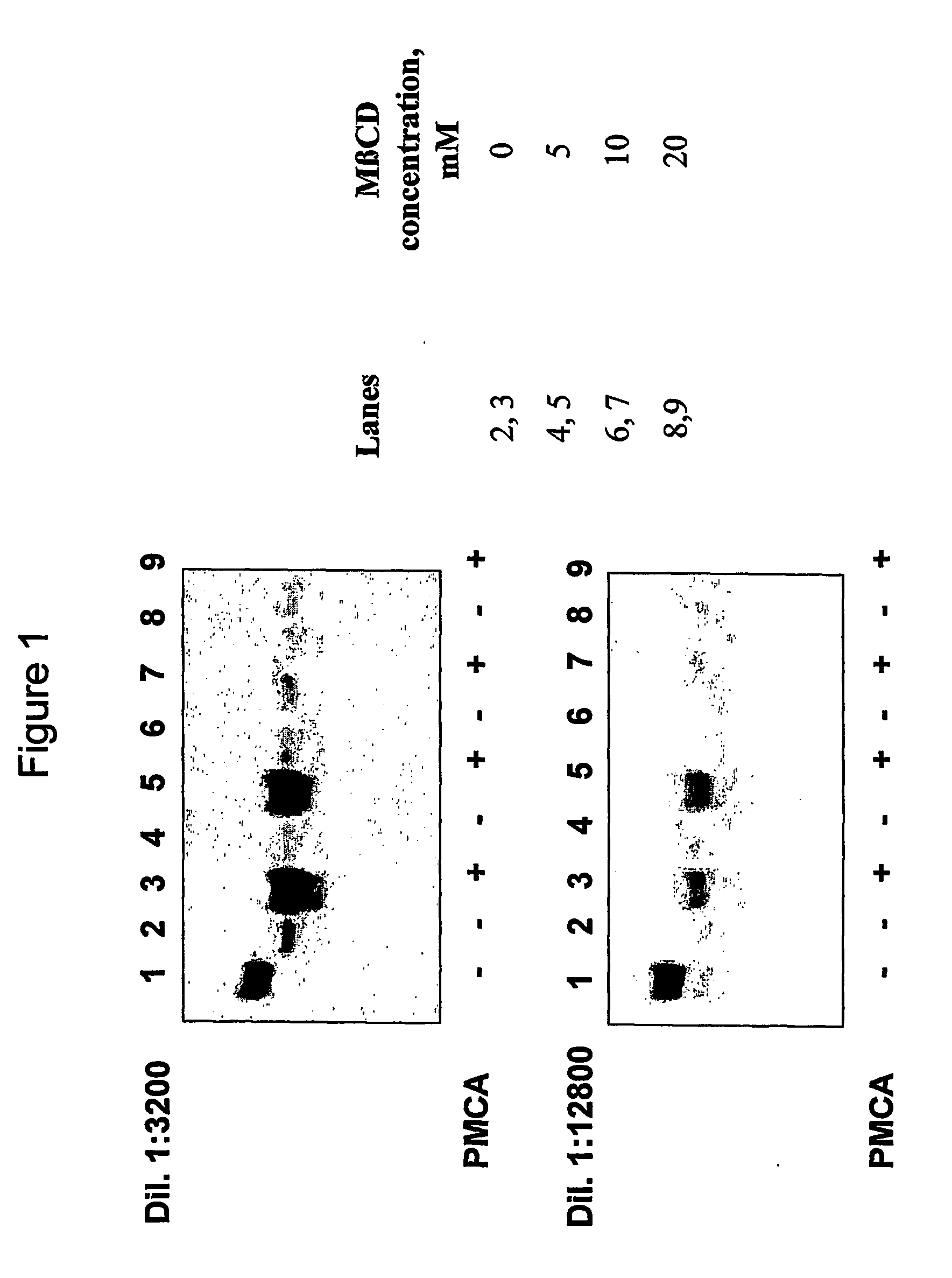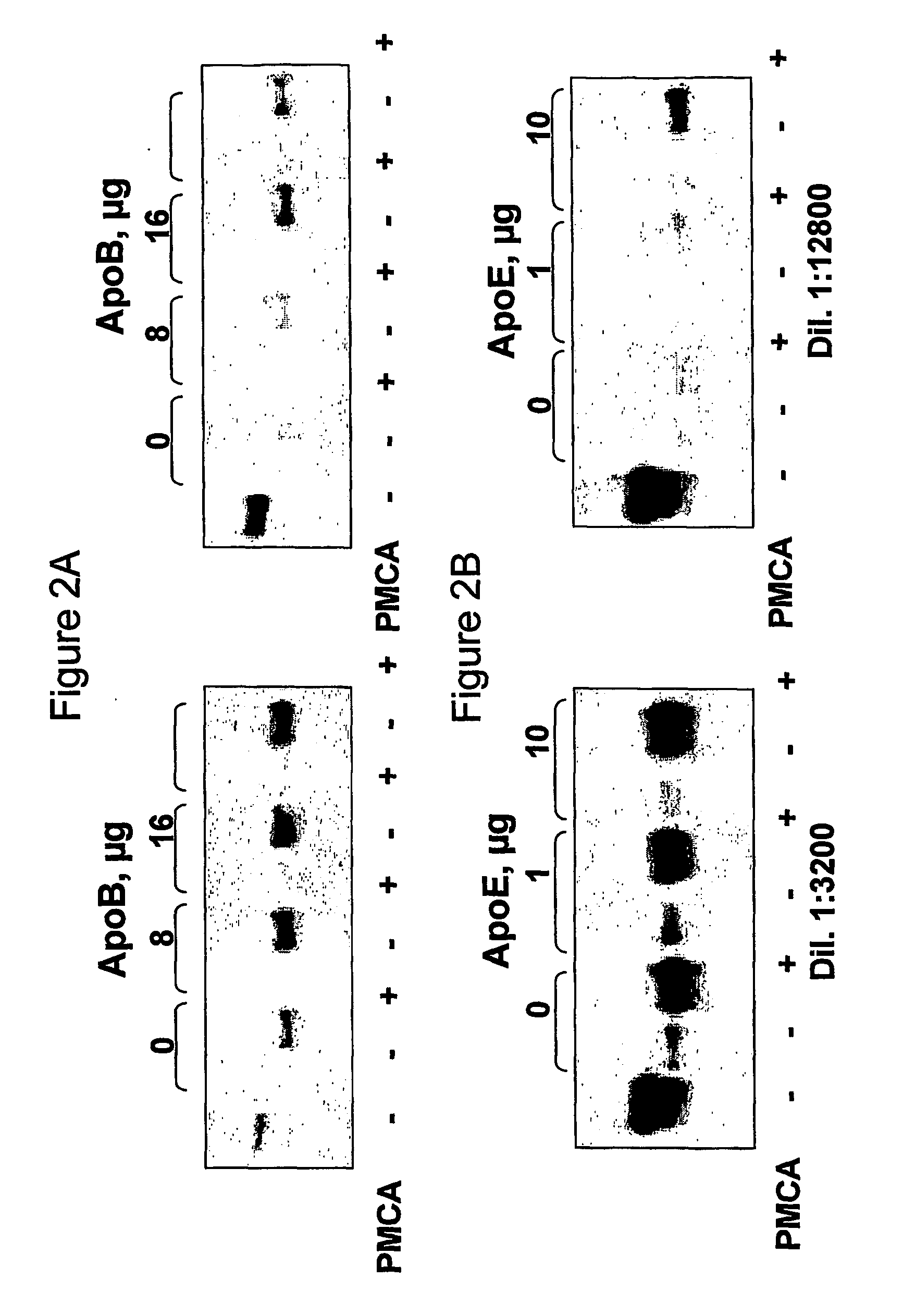Use of prion conversion modulating agents
a technology of prion conversion and modulating agent, which is applied in the field of prion conversion modulating agent, can solve the problems of no therapy available, no other plausible hypothesis, and physicochemical procedures that inactivate most viruses, such as disrupting nucleic acids, have proved ineffective in reducing the infectivity of tse pathogens
- Summary
- Abstract
- Description
- Claims
- Application Information
AI Technical Summary
Benefits of technology
Problems solved by technology
Method used
Image
Examples
example 1
In vitro Prion Replication in Brain Homogenate through PMCA Assay
[0109] The influence of cholesterol and some of the apolipoproproteins on prion replication in vitro is analysed through a Protein Misfolding Cyclic Amplification assay (PMCA) (Saborio et al., 2001) where hamster brain homogenate is used as a source of PrPC and conversion factors as follows.
[0110] a) Brain preparation:
[0111] Brains from healthy Syrian golden hamsters healthy or infected with the adapted scrapie strain 263 K are obtained after decapitation and immediately frozen in dry ice and kept at −0′ until used. Brains are homogenized in PBS containing protease inhibitors (Complete™ cocktail from Boehringer Mannheim) at a 1× final concentration. Detergents (0.5% Triton X-100, 0.05% SDS, final concentrations) are added and samples clarified with low speed centrifugation (10000 g) for 1 min, using an Eppendorf centrifuge (model 5415).
[0112] Dilutions (3200-fold and 12800-fold) of the scrapie brain homogenate are ...
example 2
In vitro Prion Replication in Lipid Rafts from Prion Infection Sensitive Cells by PMCA
[0120] The mouse neuroblastoma cell line N2a is used for their capability to be infected with PrPSc. Baron et al., 2002 and Enari et al., 2001 have shown that prion infection sensitive and prion infection resistant N2a sub-lines exist. Lipid rafts from the prion infection sensitive line are isolated and used as a substrate for PMCA assay. The effect of an apolipoprotein B antagonist on prion conversion is studied through the ability of apolipoprotein B antagonist to inhibit the prion replication ability of prion infection sensitive N2a cell lines.
[0121] a) N2a cell preparation:
[0122] Sub-clones of the parental mouse neuroblastoma N2a cell line are derived from single cells by limit dilution. A growing culture (Dulbecco's Modified Eagles Medium (DMEM Gibco # 41966-029), containing 10% fetal calf serum (FCS) and supplemented with 2 mM, L-glutamate and standard antibiotics (penicillin and streptomy...
example 3
Proteomics Analysis of Lipid Rafts of Prion Infection Resistant and Sensitive Cells
[0153] Since the two cell preparations are indistinguishable in terms of their PrP content a more complete protein comparison using 2D gel electrophoresis was performed to show differences in other proteins that might underline the difference in conversion activity between the two sub-clones.
[0154] 2D gel preparations are prepared as follows:
[0155] Acetone precipitated proteins (see §c) are re-suspended in 20 μl 1% SDS, 0.23% DTT and heated to 95° C. for 5 min After the preparation is cooled to room temperature, 25 μl of a solution (9M urea, 4% CHAPS, 65 mM DTT, 35 mM Tris base) is added.
[0156] Fifteen minutes later, 85 μl of a solution containing 7M urea, 2M thiourea, 4% CHAPS, 100 mM DTT is further added to the mixture. After a further 15 min, non-solubilized material is removed by centrifugation at 14000 RPM during 5 min and the supernatant is applied directly to a 7 cm IPG strip and left to re...
PUM
| Property | Measurement | Unit |
|---|---|---|
| Atomic weight | aaaaa | aaaaa |
| Atomic weight | aaaaa | aaaaa |
| Molecular weight | aaaaa | aaaaa |
Abstract
Description
Claims
Application Information
 Login to View More
Login to View More - R&D
- Intellectual Property
- Life Sciences
- Materials
- Tech Scout
- Unparalleled Data Quality
- Higher Quality Content
- 60% Fewer Hallucinations
Browse by: Latest US Patents, China's latest patents, Technical Efficacy Thesaurus, Application Domain, Technology Topic, Popular Technical Reports.
© 2025 PatSnap. All rights reserved.Legal|Privacy policy|Modern Slavery Act Transparency Statement|Sitemap|About US| Contact US: help@patsnap.com



